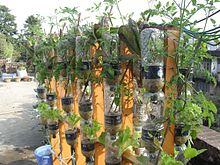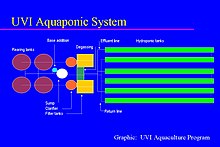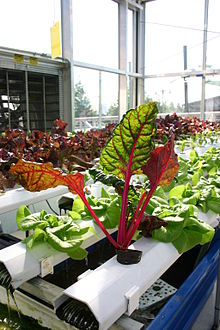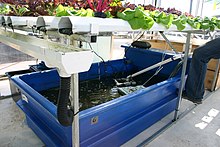Published on Sept 5, 2012
Join Mike to view his first
aquaponics system.
Follow Mike as he grows with his system and learns the ups and downs of aquaponics.
Mike will be providing regular updates so you can see how his system is doing in the heat of sunny Florida.
Follow Mike as he grows with his system and learns the ups and downs of aquaponics.
Mike will be providing regular updates so you can see how his system is doing in the heat of sunny Florida.
In normal aquaculture, excretions from the animals being raised can accumulate in the water, increasing toxicity.
In an aquaponic system, water from an aquaculture system is fed to a hydroponic system where the by-products are broken down by nitrogen-fixing bacteria into nitrates and nitrites, which are utilized by the plants as nutrients.
The water is then recirculated back to the aquaculture system.
As existing hydroponic and aquaculture farming techniques form the basis for all aquaponics systems, the size, complexity, and types of foods grown in an aquaponics system can vary as much as any system found in either distinct farming discipline.[1]
History
Aquaponics has ancient roots, although there is some debate on its first occurrence:
- Aztec cultivated agricultural islands known as chinampas in a system considered by some to be the first form of aquaponics for agricultural use[2][3] where plants were raised on stationary (and sometime movable) islands in lake shallows and waste materials dredged from the Chinampa canals and surrounding cities were used to manually irrigate the plants.[2][4]
- South China, Thailand, and Indonesia who cultivated and farmed rice in paddy fields in combination with fish are cited as examples of early aquaponics systems.[5] These polycultural farming systems existed in many Far Eastern countries and raised fish such as the oriental loach (泥鳅, ドジョウ),[6] swamp eel (黄鳝, 田鰻), Common (鯉魚, コイ) and crucian carp (鯽魚) [7] as well as pond snails (田螺) in the paddies.[8][9]
Floating aquaponics systems on polycultural fish ponds were installed in
China in more recent years on a large scale growing rice, wheat and
canna lily and other crops,[10] with some installations exceeding 2.5 acres (10,000 m2).[11]
Inspired by the successes of the New Alchemy Institute, and the reciprocating aquaponics techniques developed by Dr. Mark McMurtry et al., other institutes soon followed suit.
Starting in 1997, Dr. James Rakocy and his colleagues at the University of the Virgin Islands researched and developed the use of deep water culture hydroponic grow beds in a large-scale aquaponics system.[12]
The first aquaponics research in Canada was a small system added onto existing aquaculture research at a research station in Lethbridge, Alberta.
Canada saw a rise in aquaponics setups throughout the ’90s, predominantly as commercial installations raising high-value crops such as trout and lettuce.
A setup based on the deep water system developed at the University of Virgin Islands was built in a greenhouse at Brooks, Alberta where Dr. Nick Savidov and colleagues researched aquaponics from a background of plant science.
The Caribbean island of Barbados created an initiative to start aquaponics systems at home, with revenue generated by selling produce to tourists in an effort to reduce growing dependence on imported food.
In Bangladesh, the world's most densely populated country, most farmers use agrochemicals to enhance food production and storage life, though the country lacks oversight on safe levels of chemicals in foods for human consumption.[14]

Vegetable production part of the low-cost Backyard Aquaponics System developed at Bangladesh Agricultural University
To combat this issue a team led by Professor Dr. M.A. Salam at the Department of Aquaculture of Bangladesh Agricultural University, Mymensingh has created plans for a low-cost aquaponics system to provide chemical-free produce and fish for people living in adverse climatic conditions such as the salinity-prone southern area and the flood-prone haor area in the eastern region.[15][16]
Dr. Salam's work innovates a form of subsistence farming for micro-production goals at the community and personal levels whereas design work by Chowdhury and Graff was aimed exclusively at the commercial level, the latter of the two approaches take advantage of economies of scale.
There has been a shift towards community integration of aquaponics, such as the nonprofit foundation Growing Power that offers Milwaukee youth job opportunities and training while growing food for their community.
The model has spawned several satellite projects in other cities, such as New Orleans where the Vietnamese fisherman community has suffered from the Deepwater Horizon oil spill, and in the South Bronx in New York City.[17]
Whispering Roots is a non-profit organization in Omaha, Nebraska that provides fresh, locally grown, healthy food for socially and economically disadvantaged communities by using aquaponics, hydroponics and urban farming.[18]
In addition, aquaponic gardeners from all around the world have gathered in online community sites and forums to share their experiences and promote the development of this form of gardening[19] as well as creating extensive resources on how to build home systems.
Recently, aquaponics has been moving towards indoor production systems. In cities like Chicago, entrepreneurs are utilizing vertical designs to grow food year round.[20]
Components
Aquatic effluents, resulting from uneaten feed or raising animals like fish, accumulate in water due to the closed-system re-circulation of most aquaculture systems.
The effluent-rich water becomes toxic to the aquatic animal in high concentrations but these effluents are nutrients essential for plant growth.[21]
Although consisting primarily of these two parts, aquaponics systems are usually grouped into several components or subsystems responsible for the effective removal of solid wastes, for adding bases to neutralize acids, or for maintaining water oxygenation.[21]
Typical components include:
- Rearing tank: the tanks for raising and feeding the fish;
- Settling basin: a unit for catching uneaten food and detached biofilms, and for settling out fine particulates;
- Biofilter: a place where the nitrification bacteria can grow and convert ammonia into nitrates, which are usable by the plants;[21]
- Hydroponics subsystem: the portion of the system where plants are grown by absorbing excess nutrients from the water;
- Sump: the lowest point in the system where the water flows to and from which it is pumped back to the rearing tanks.

A commercial aquaponics system. An electric pump moves effluent
rich water from the fish tank through a solids filter to remove
particles the plants above cannot absorb. The water then provides
nutrients for the plants and is cleansed before returning to the fish
tank below where the process repeats.
This enables them to filter out the ammonia that is toxic to the aquatic animals, or its metabolites.
After the water has passed through the hydroponic subsystem, it is cleaned and oxygenated, and can return to the aquaculture vessels.
This cycle is continuous. Common aquaponic applications of hydroponic systems include:
- Deep-water raft aquaponics: styrofoam rafts floating in a relatively deep aquaculture basin in troughs.
- Recirculating aquaponics: solid media such as gravel or clay beads, held in a container that is flooded with water from the aquaculture. This type of aquaponics is also known as closed-loop aquaponics.
- Reciprocating aquaponics: solid media in a container that is alternately flooded and drained utilizing different types of siphon drains. This type of aquaponics is also known as flood-and-drain aquaponics or ebb-and-flow aquaponics.
- Other systems use towers that are trickle-fed from the top, nutrient film technique channels, horizontal PVC pipes with holes for the pots, plastic barrels cut in half with gravel or rafts in them. Each approach has its own benefits.[23]
Most green leaf vegetables grow well in the hydroponic subsystem, although most profitable are varieties of chinese cabbage, lettuce, basil, roses, tomatoes, okra, cantaloupe and bell peppers.[22]
Other species of vegetables that grow well in an aquaponic system include beans, peas, kohlrabi, watercress, taro, radishes, strawberries, melons, onions, turnips, parsnips, sweet potato and herbs.[citation needed]
Since plants at different growth stages require different amounts of minerals and nutrients, plant harvesting is staggered with seedings growing at the same time as mature plants. This ensures stable nutrient content in the water because of continuous symbiotic cleansing of toxins from the water.[24]

A Deep Water Culture hydroponics system where plant grow directly into the effluent rich water without a soil
medium. Plants can be spaced closer together because the roots do not
need to expand outwards to support the weight of the plant.
Animals: aquaculture
Main article: Aquaculture
In practice, tilapia are the most popular fish for home and commercial projects that are intended to raise edible fish, although barramundi, Silver Perch, Eel-tailed catfish or tandanus catfish, Jade perch and Murray cod are also used.[22]
For temperate climates when there isn't ability or desire to maintain water temperature, bluegill and catfish are suitable fish species for home systems. Koi and goldfish may also be used, if the fish in the system need not be edible.
Bacteria
Further information: Nitrogen Cycle
Ammonia is steadily released into the water through the excreta and gills of fish as a product of their metabolism, but must be filtered out of the water since higher concentrations of ammonia (commonly between 0.5 and 1 ppm)[citation needed] can kill fish.
Although plants can absorb ammonia from the water to some degree, nitrates are assimilated more easily,[22] thereby efficiently reducing the toxicity of the water for fish.[21]
Ammonia can be converted into other nitrogenous compounds through healthy populations of:
- Nitrosomonas: bacteria that convert ammonia into nitrites, and
- Nitrobacter: bacteria that convert nitrites into nitrates.
The submerged roots of the vegetables combined have a large surface area, so that many bacteria can accumulate there.
Together with the concentrations of ammonia and nitrites in the water, the surface area determines the speed with which nitrification takes place.
Care for these bacterial colonies is important as to regulate the full assimilation of ammonia and nitrite. This is why most aquaponics systems include a bio-filtering unit, which helps facilitate growth of these microorganisms.
Typically, after a system has stabilized ammonia levels range from 0.25 to 2.0 ppm; nitrite levels range from 0.25 to 1 ppm, and nitrate levels range from 2 to 150 ppm.[citation needed]
During system start-up, spikes may occur in the levels of ammonia (up to 6.0 ppm) and nitrite (up to 15 ppm), with nitrate levels peaking later in the start-up phase.[citation needed]
Since the nitrification process acidifies the water, non-sodium bases such as potassium hydroxide or calcium hydroxide can be added for neutralizing the water's pH[21] if insufficient quantities are naturally present in the water to provide a buffer against acidification.
In addition, selected minerals or nutrients such as iron can be added in addition to the fish waste that serves as the main source of nutrients to plants.[21]
A good way to deal with solids buildup in aquaponics is the use of worms, which liquefy the solid organic matter so that it can be utilized by the plants and/or animals.
Source: Wikipedia.org
Somebody Come and Play Today! Earn as You Learn, Grow as You Go!
The Man Inside the Man
from
Sinbad the Sailor Man
A
JMK's Production
Share this page
TTFN
CYA Later Taters!
Thanks for stopping by.
Donnie/Sinbad the Sailor Man
P.S. Sweet Sixteen My Breakout Year's Hottest and Fastest Growing Biz Op? Do You Want In? If You Do! Click Here and Sign Up!





No comments:
Post a Comment